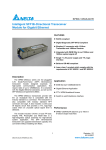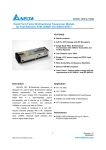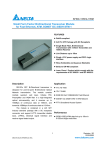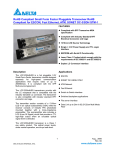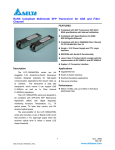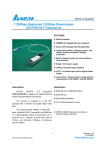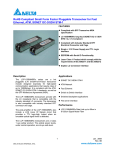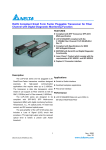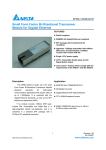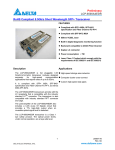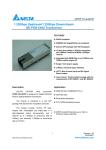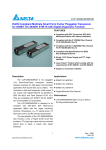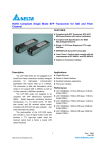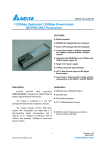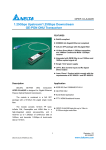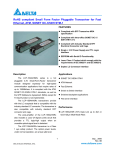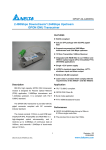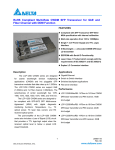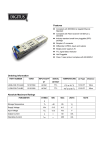Download Delta Electronics SPBD-155E4J1RD User's Manual
Transcript
SPBD-155E4J1RD Intelligent SFP Bi-Directional Transceiver Module for Fast Ethernet, ATM, SONET OC-3/SDH STM-1 FEATURES RoHS compliant Digital Diagnostic SFF-8472, Rev. 9.5 MSA compliant Simplex LC connector with 1310nm Transmitter and 1550nm Receiver Single + 3.3V power supply and TTL logic interface Bellcore GR-468 compliant Laser class 1 product which comply with the requirements of IEC 60825-1 and IEC 60825-2 Description Application The SPBD-155xxxxx series are hot pluggable 3.3V Small-Form-Factor (SFP) Bi-Directional transceiver module designed expressly for high-speed communication applications that require rates of up to 155Mbit/sec. It is compliant with the Fast Ethernet, ATM, SONET OC-3/SDH STM-1 standards, as well as the SFP Multisource Agreement (MSA). TTC TS-1000 ITU-T G.985 IEEE 802.3ah 100BASE-BX/ Fast Ethernet SONET OC-3/SDH STM-1 FTTx WDM Broadband Access The SPBD-155xxxxx transceivers provide with the LC receptacle that is compatible with the industry standard LC connector. The transceiver is also compatible with industry standard RFT connector and cage. It also includes a LOS (Loss Of Signal) circuit that provides a TTL logic-high output when an unusable optical signal level is detected. Switch to switch/backbone interface Performance SPBD-155E4J1RD data link up to 15km in 9/125um single mode fiber. The module includes 1310nm un-cool FP laser, InGaAs PIN, Preamplifer and WDM filter in a high-integrated optical assembly for high-density system application. The SFP Bi-Directional transceiver can upgrade transmission capacity very convenient without installing new fibers. 1 DELTA ELECTRONICS, INC. Revision: S1 04/11/2007 www.deltaww.com SPBD-155E4J1RD 1. Absolute Maximum Ratings Parameter Storage Temperature Storage Ambient Humidity Power Supply Voltage Signal Input Voltage Optical Input Power (Peak) Symbol Ts HA VCC Min. -40 5 0 -0.3 Typ. Max. 85 95 5 Vcc+0.3 +4 Unit ºC % V V dBm Note Min. -5 5 3.135 Typ. Max. 75 85 3.465 300 100 155.52 15 Unit ºC % V mA mVp-p Mbps km Note Note (1) Symbol Min. Typ. Max. PO -14 -8 ER 10 λC 1260 1310 1360 σ 6 POff -45 tr/tf 1.3 TJ 1 ORLT 14 -116 RIN TDP 1 Compliant with Bellcore TR-NWT-000253 and ITU recommendation G.957 Unit dBm dB nm nm dBm ns ns dB dB/Hz dB 2. Recommended Operating Conditions Parameter Operating Case Temperature Ambient Humidity Power Supply Voltage Power Supply Current Power Supply Noise Rejection Data Rate Transmission Distance Symbol TC HA VCC ICC 3.3 10 Non-condensing 100Hz to 1MHz Note (1). Measured on topside of case front center. 3. Specification of Transmitter Parameter Average Launched Power Optical Extinction Ratio Center Wavelength Spectrum Width (RMS) Transmitter OFF Output Power Optical Rise/Fall Time Total Jitter Optical Return Loss Tolerance Relative Intensity Noise Dispersion Penalty Output Eye Mask Note Note (1) FP Laser Note (2) Note (3) Note (4) Note (1). Launched power (avg.) is power coupled into a single mode fiber. Note (2). These are unfiltered 20-80% values. Note (3). Measure at 223-1 NRZ PRBS pattern. Note (4). Eye Mask definition 1.20 Amplitude 1.00 Mean level of logical "1" 0.80 0.50 0.20 0.00 Mean level of logical "0" -0.20 0.00 0.15 0.35 0.65 Time 2 0.85 1.00 Optical Pulse Mask with Bessel Filter Specified in ITU-T G.957 DELTA ELECTRONICS, INC. Revision: S1 04/11/2007 www.deltaww.com SPBD-155E4J1RD 4. Specification of Receiver Parameter Input Optical Wavelength Receiver Sensitivity Input Saturation Power (Overload) LOS-Deassert Power LOS-Assert Power LOS Hysteresis Optical Reflectance Output Data Rise/Fall time S/X Endurance Optical Isolation Symbol λIN PIN PSAT PA PD PA-PD Min. 1480 -3 -44 0.5 Typ. Max. 1600 -31 -31 2 5 -14 1.5 10 tr/tf 25 -10 Unit nm dBm dBm dBm dBm dB dB ns dB dB Note PIN-PD Note (1) Note (2) Note (3) Note (4) Note (5) Note (6) 23 Note (1). Measured with 1520nm, ER=10dB; BER =<10 @PRBS=2 -1 NRZ Note (2). When LOS asserted, the data output is Low-level (fixed) Note (3). When the terminal is viewed from the optical path, the reflection toward the optical path of the optical signal with a central wavelength of 1480nm to 1580nm transmitted to terminal. Note (4). These are 20%~80% values Note (5). X=10 MHz, Rectangular BER =10-10 Note (6). Receiver isolation between 1260nm ~1360nm 5. Electrical Interface Characteristics Parameter Transmitter Total Supply Current Differential Data Input Swing Differential line input Impedance Transmitter Disable Input-High Transmitter Disable Input-Low Transmitter Fault Output-High Transmitter Fault Output-Low Transmitter Fault Pull up Resistor Receiver Total Supply Current Differential Data Output Swing LOS Output Voltage-High LOS Output Voltage-Low Receiver LOS Load Symbol Min. ICC VDT RIN VDISH VDISL VTXFH VTXFL RTX_FAULT 500 80 2 0 2 0 4.7 ICC VDR VLOSH VLOSL RRXLOS 400 2 0 4.7 Typ. 100 Max. Unit Note A 2400 120 VCC 0.8 VCC+0.3 0.8 10 mA mVp-p Ohm V V V V kΩ Note (1) B 2000 VCC+0.3 0.8 10 mA mVp-p V V kΩ Note (1) Note (4) Note (2) Note (3) Note (3) Note (1). A (TX)+ B (RX) = 300mA (A: Not include termination circuit; B: using a resister of 150Ω between Data-output and ground) Note (2). There is an internal 4.7 to 10kΩ pull-up resistor to VccT. Note (3). Pull up to VCC on host Board. Note (4). Internally AC coupled with LVPECL output, but requires a 100Ohm differential termination at or internal to Serializer/ Deserializer. 3 DELTA ELECTRONICS, INC. Revision: S1 04/11/2007 www.deltaww.com SPBD-155E4J1RD 6. Enhanced Digital Diagnostic Interface The memory map in the following describes an extension to the memory map defined in SFP MSA. The enhanced interface uses the two wire serial bus address 1010001X(A2h) to provide diagnostic information about the module’s present operating conditions. 2 wire address 1010000 X (A0h) 2 wire address 1010001 X (A2h) 0 0 Alarm and Warning Thresholds (56 bytes) Serial ID Defined by SFP MSA (96 bytes) 55 56 Cal Constants (40 bytes) 95 96 95 96 Real Time Diagnostic Interface (24 bytes) Vender Specific (32 bytes) 119 120 Vender Specific 127 127 128 128 User Writable EEPROM (120 bytes) Reserved in SFP MSA (128 bytes) 247 248 255 255 Vender Specific (8 bytes) 7. Digital Diagnostic Monitor Accuracy Parameter Accuracy ± 3℃ Transceiver Internal Temperature Power Supply Internal Voltage ± 3% TX Bias Current ± 10% TX Optical Power ± 3dB RX Optical Power ± 3dB Unit ℃ V mA dBm dBm Calibration Internal Internal Internal Internal Internal Note TC=-5~+75℃ VCC=3.3V±5% Specified by nominal bias value -14 to -8dBm -31 to -8dBm Note. Temperature and Voltage is measured internal to the transceiver. 4 DELTA ELECTRONICS, INC. Revision: S1 04/11/2007 www.deltaww.com SPBD-155E4J1RD 8. Pin Description SFP Transceiver Electrical Pad Layout Host Board Connector Pad Layout Pin Function Definitions Pin Num. 1 2 3 4 5 6 7 8 9 10 11 12 13 14 15 16 17 18 19 20 Name VeeT TX Fault TX Disable MOD-DEF2 MOD-DEF1 MOD-DEF0 Rate Select LOS VeeR VeeR VeeR RDRD+ VeeR VccR VccT VeeT TD+ TDVeeT Function Transmitter Ground Transmitter Fault Indication Transmitter Disable Module Definition 2 Module Definition 1 Module Definition 0 Not Connect Loss of Signal Receiver Ground Receiver Ground Receiver Ground Inv. Received Data Out Received Data Out Receiver Ground Receiver Power Transmitter Power Transmitter Ground Transmit Data In Inv. Transmit Data In Transmitter Ground Plug Seq. 1 3 3 3 3 3 3 3 1 1 1 3 3 1 2 2 1 3 3 1 Notes Note (1) Note (2) Note (3) Note (4), 2 wire serial ID interface Note (4), 2 wire serial ID interface Note (4), Grounded in Module Function not available Note (5) Note (6) Note (6) Note (7) Note (7) Note (8) Note (8) Plug Seq.: Pin engagement sequence during hot plugging. 5 DELTA ELECTRONICS, INC. Revision: S1 04/11/2007 www.deltaww.com SPBD-155E4J1RD Notes: 1) Circuit ground is internally isolated from frame (chassis) ground. Tx GND and Rx GND may be internally isolated within the TRx module. 2) TX Fault is an open collector/drain output, which should be pulled up with a 4.7K~10KΩ resistor on the host board. Pull up voltage between 2.0V and VccT+0.3V. The output indicates Low when the transmitter is operating normally, and High with a laser fault including laser end-of-life. In the low state, the output will be pulled to less than 0.8V. 3) TX disable is an input that is used to shut down the transmitter optical output. It is pulled up within the module with a 4.7 – 10 K Ω resistor. Its states are: 4) Low (0 – 0.8V): Transmitter on (>0.8, < 2.0V): Undefined High (2.0 – 3.465V): Transmitter Disabled Open: Transmitter Disabled Mod-Def 0,1,2. These are the module definition pins. They should be pulled up with a 4.7K – 10KΩresistor on the host board. The pull-up voltage shall be VccT or VccR. Mod-Def 0 is grounded by the module to indicate that the module is present Mod-Def 1 is the clock line of two-wire serial interface for serial ID Mod-Def 2 is the data line of two-wire serial interface for serial ID 5) LOS (Loss of Signal) is an open collector/drain output, which should be pulled up with a 4.7K – 10KΩ resistor. Pull up voltage between 2.0V and VccR+0.3V. When high, this output indicates the received optical power is below the worst-case receiver sensitivity. Low indicates normal operation. In the low state, the output will be pulled to less than 0.8V. 6) RD-/+: These are the differential receiver outputs. They are AC coupled 100Ω differential lines which should be terminated with 100Ω (differential) at the user SERDES. The AC coupling is done inside the module and is thus not required on the host board. The voltage swing on these lines will be between 400 and 2000 mV differential (200 – 1000 mV single ended) when properly terminated. 7) VccR and VccT are the receiver and transmitter power supplies. They are defined as 3.3V ±5% at the SFP connector pin. Recommended host board power supply filtering is shown below page. Inductors with DC resistance of less than 1 Ohm should be used in order to maintain the required voltage at the SFP input pin with 3.3V supply voltage. When the recommended supply-filtering network is used, hot plugging of the SFP transceiver module will result in an inrush current of no more than 30 mA greater than the steady state value. 8) TD-/+: These are the differential transmitter inputs. They are AC-coupled, differential lines with 100 Ω differential termination inside the module. The AC coupling is done inside the module and is thus not required on the host board. The inputs will accept differential swings of 500 – 2400 mV (250 – 1200 mV single-ended), though it is recommended that values between 500 and 1200 mV differential (250 – 600 mV single-ended) be used for best EMI performance. 6 DELTA ELECTRONICS, INC. Revision: S1 04/11/2007 www.deltaww.com SPBD-155E4J1RD 9. Recommend Interface Circuit VCC 1uH 3.3V Protocol Vcc DELTA SFP Module 1uH RES1 10uF 0.1uF 0.1uF VccT 10k Ohms Tx_Disable Tx_Disable Tx_Fault Tx_Fault TD + 0.01uF 100 Ohms TD - Protocol IC Laser Driver Laser Diode 0.01uF VeeT SerDes IC VccR RES1 10uF 0.1uF RD + 0.01uF RD - 0.01uF 100 Ohms* Preamp & Quantizer Photo Diode Rx_LOS Rx_LOS 3.3V VeeR RES1 RES1 RES1 PLD / PAL Mod_def 2 EEPROM Mod_def 1 Mod_def 0 RES1 = 4.7k to 10k Ohms * Depands on SerDes IC used SFP Host Board Schematic Design criterion of the capacitor used is the resonant frequency and its value must be in the order of the nominal data rate. Short trace lengths are mandatory. Recommended Host Board Supply Filtering Network 7 DELTA ELECTRONICS, INC. Revision: S1 04/11/2007 www.deltaww.com SPBD-155E4J1RD 10. Outline Dimensions Complies with 21 CFR 1040.10 and 1040.11 Made in x FS Class 1 Laser Product XXXX nm Tx / Rx XXXX nm Week (52Weeks/Year) : 1月2日=01 Transmitter Wavelength 1310nm 1550nm Latch Color Identifier Black Yellow 8 DELTA ELECTRONICS, INC. Revision: S1 04/11/2007 www.deltaww.com SPBD-155E4J1RD 11. Regulatory Compliance Feature Electrostatic Discharge (ESD) to the Electrical Pins Test Method Reference Performance Human Body Model MIL-STD-883E Method 3015.7 (HBM) EIA-JESD22-A114 (1) Satisfied with Machine Model (MM) EIA-JESD22-A115 Electrostatic Discharge (ESD) to the Simplex Receptacle Contact Discharge Air Discharge Radio Frequency Electromagnetic Field Immunity IEC/EN 61000-4-2 IEC/EN 61000-4-3 electrical characteristics of product spec. (2) No physical damage FCC Part 15 Class B EN 55022 Class B Electromagnetic Interference (EMI) Laser Eye Safety IEC/EN 61000-4-2 (CISPR 22A) FDA/CDRH FDA 21CFR 1040.10, 1040.11 CDRH File # 0420993 TUV IEC/EN 60825-1 IEC/EN 60825-2 TUV Certificate R50032471 TUV IEC/EN 60950 UL/CSA UL 60950 # Component Recognition UL File # E239394 Appendix A. Document Revision Version No. S0 Date 2006-09-05 S1 2007-04-11 Description Preliminary datasheet Change the Receiver Differential Data Output Swing from CML to LVPECL output 9 DELTA ELECTRONICS, INC. Revision: S1 04/11/2007 www.deltaww.com










